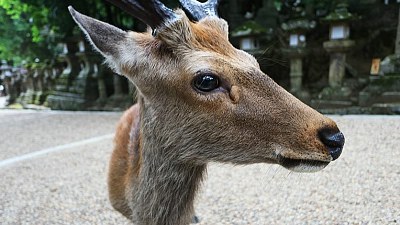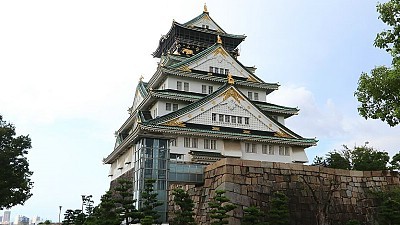Travel restarting: Hiroshima

As part of our reporting on Japan's efforts to restart local tourism after the extraordinary disruption caused by the coronavirus epidemic, I was excited to find myself a few weeks ago on a very quick tour of some of the main attractions in Hiroshima and nearby Miyajima.
The sky looked bright and clear as my train arrived into Hiroshima Station, but would gradually darken throughout the day as Typhoon Haishen crept across the Philippine Sea and towards my part of the country.
Peace Memorial Park and Museum
From the station, I took tram number 2 to Genbaku Dome-mae, where the ruins of the Prefectural Industrial Promotion Hall, reduced to a skeleton by the atomic bomb on August 6, 1945 and today known as the A-Bomb Dome, still stands as a haunting reminder of the events of that day.
Directly across the Motoyasu River stands a similarly affecting monument to the atomic bomb's thousands of child victims. Standing atop a tripedal dome structure bearing a traditional bell and a windchime, a young girl holds aloft the skeletal frame of a folded crane, symbolizing the humanity's hope for peace. The girl is modeled on Sasaki Sadako, only two years old at the time of the blast, who died at the age of twelve from the effects of radiation. Before passing away, she famously folded a thousand origami cranes expressing her wish for a world without nuclear weapons.

Towards the center of the park, the Memorial Cenotaph is a plain, concrete arch suggesting an ancient house, sheltering a stone chamber holding the names of all those killed by the blast or the lingering effects of radiation. The simple but elegant structure is located at one end of a small rectangular lake, framing the Peace Flame and the A-Bomb Memorial in the distance. Apart from a few passersby and one group of elementary-aged kids on a school trip, the park was today largely empty of visitors.

My last stop here was the Peace Memorial Museum, with exhibitions spread across two buildings, covering the history of the city, the events of the atom bomb attack and accounts, many profoundly upsetting, of lives horrifically impacted or cut short. In common with all the major attractions I've visited in recent months the museum now requires facemasks to be worn and a temperature scan prior to entry, and is one of just a few requiring a name and address so that the government can get in touch in the event of a possible infection cluster. Although far from crowded, I did encounter a steady stream of visitors as I made my way through the exhibitions.


Miyajima
With the direct boat from the Peace Park operating on a much-reduced schedule, I retraced my steps to Hiroshima Station and took the JR Sanyo Line to Miyajimaguchi where I boarded a JR ferry to the island. As I arrived into the port, I found the covered shopping street, seafront and area around the famous floating torii (currently covered for renovation) quieter than I had ever seen before, with just a few tourists dotted around in groups and easily outnumbered by locals and staff.





Itsukushima Shrine
One of Japan's most beautiful and unique Shinto structures, Itsukushima Shrine was erected by the powerful warlord Taira Kiyomori in 1163, and despite being rebuilt several times, the 12th century style of its architecture has been faithfully preserved. Built on a lattice of pier-like structures extending out over an inlet, the shrine appears to float when the tide rises beneath it.

Usually the island's most popular attraction, the shrine seemed almost deserted today and for much of my visit I shared its brightly decorated corridors with just one young couple.


Momijidani Park
Passing through to the far side of the shrine, I took an uphill path leading through Momijidani Park, another of the island's most popular beauty spots, known for its impressive number and variety of maple trees. Making my way past the famous Iwaso Ryokan and over an attractive red bridge, I saw just a handful of other visitors admiring the lush, green foliage, with just a few red leaves beginning to show.



I had planned to take the ropeway to the top of Mount Misen to enjoy its panoramic view of the island and surrounding ocean, but found it closed due to the aproaching typhoon.
Daishoin Temple
Denied the chance to see one of my favourite ocean views but with some extra time to spare, I made my way to Daishoin - an important temple of the esoteric Shingon school of Buddhism and one of my favourite spots on the island. From its leafy surroundings and hundreds of rakan statues - each sporting their own brightly colored knitted caps - to its spinning dharma wheels, the temple complex is packed with fascinating little details, but today I had the space almost entirely to myself.





With the sky beginning to darken noticeably, I retraced my steps towards the shore and back along the covered shopping street to the port, where I took a ferry to the mainland and changed to the JR Sanyo Line for Hiroshima Station.
Shukkeien Garden
Back in Hiroshima, my next stop was the beautiful landscape garden of Shukkeien, a short walk northeast of the station on the far bank of the Enko River.
Constructed by the first daimyo of the Hiroshima Asano domain in 1620, the garden was designed as a series of highly idealised views in miniature - from pine forests and rolling hills to rice fields - joined by a single winding path and arranged around a large pond possibly representing the West Lake of Hangzhou in China. Although perhaps a bit quieter than usual like all of the sites on my itinerary, I did see around a dozen visitors making it one of the day's busier spots.




Hiroshima Castle
From Shukkeien I took a short walk directly west to my final sightseeing stop of the day at Hiroshima Castle, an elegant reconstruction of the original building - destroyed like so many others by the atomic bomb - with an attractive wooden facade disguising its mostly concrete structure. By now it was beginning to rain, so I wasn't surprised to see just a handful of other visitors as I passed under the very nicely remodelled Ninomaru Gatehouse and into the castle grounds.
After masking up and taking the usual temperature scan, I made my way up through the middle three stories, passing exhibits about the city and Japanese castle-building, to the top-floor from where I could enjoy a panoramic view of the surrounding city.


Okonomiyakimura
With my time in Hiroshima coming to an end, I had just enough time for a quick bite before my long shinkansen journey home. Built on the site known for its street food vendors in the years after World War Two, Okonomimura is best described as a multi-story food court where 25 restaurants can be found, all specializing in the city's most popular soul-food, Okonomiyaki. A popular spot with tourists and locals alike, the place was surprisingly busy and I enjoyed the lively atmosphere as I tucked into a warm and enormously comforting dish of fried batter, cabbage and pork.







